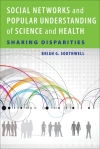Guest post by Brian Southwell
In late July 2013, Twitter posts regarding Prince George, the latest addition to the British royal family, outpaced those related to climate change by more than a 10 to 1 margin, according to the social media measurement site Topsy.com. One might argue that this signals the doom of our planet, as we seem more interested in talking about an infant prince born to a figurehead monarchy than in unprecedented change to our planet’s environment. It is not as though this was a mundane year in the annals of climate change, after all; in May, the level of carbon dioxide reached a new milestone long feared by climate researchers. That we would not spend most waking hours talking about that development might be seen either as a woeful failure or a strategy to cope with overwhelming news. In either case, our relative conversational silence about climate science seems noteworthy.
Whether talk between people actually matters to public understanding and, if so, how such exchange matters are open questions, however. To argue against the significance of talk, one can point to evidence that interpersonal exchanges, at least elements of personal expression posted online, are far from ideal as a measure of public sentiment and so we needn’t worry about what happens in social media. Researchers are discovering that there is not perfect correspondence between what’s posted in social media and broader public opinion, as reported by the Pew Research Center.
Nonetheless, what is discussed between people does have the potential to reinforce and make salient particular topics and ideas to the exclusion of others. We also know that people interact with one another in myriad ways beyond Facebook and that much interpersonal interaction can be consequential. Consider the impact of a partner rejecting condom use or a family member encouraging a particular decision about college or a friend passing along tips on using LEDs (Light-Emitting Diodes) for home lighting. Some people only learn about certain information when it is passed along to them through hallway conversation, a forwarded e-mail, or a text message. Social networks offer vital links to information, even that information which is available via mass media. What might be labeled idle chatter actually matters.
Social science research and theory offers numerous reasons why social networks provide rocky and uneven terrain for the diffusion of information. Some topics will be more often discussed than others and, importantly, some people will be more likely to share or receive information in their everyday lives through social networks. That means that we tend toward social amplification of some topics whereas other do not enjoy the same attention, even when broadcast widely via news stories.
For all of these reasons, what’s “trending” is noteworthy not only as a forecast of water cooler chat but also as a social force that warrants our attention. Consider that the next time you overhear snippets of conversation on the subway, on a playground, or in a coffee shop. Everyday life is filled with both amplifying stations and static that we often take for granted, in the form of neighbors, friends, and family.
 Brian Southwell is Senior Research Scientist at RTI International as well as a member of the faculty at the University of North Carolina at Chapel Hill and Duke University. His new book, Social Networks and Popular Understanding of Science and Health: Sharing Disparities will be out early next month.
Brian Southwell is Senior Research Scientist at RTI International as well as a member of the faculty at the University of North Carolina at Chapel Hill and Duke University. His new book, Social Networks and Popular Understanding of Science and Health: Sharing Disparities will be out early next month.
